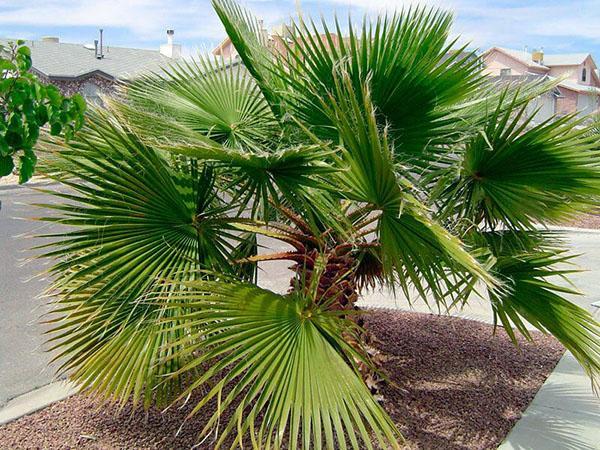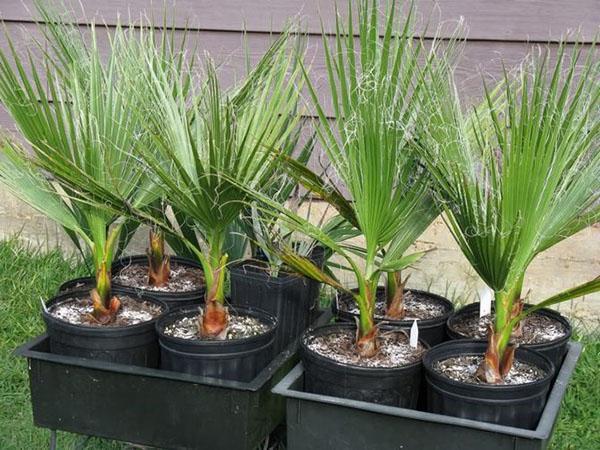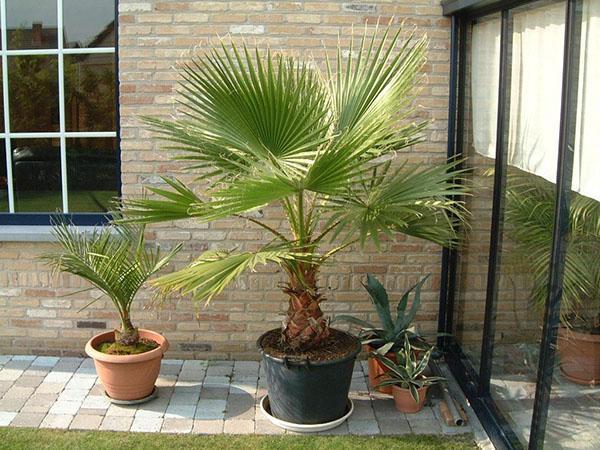Getting to know the types of washingtonia for growing at home
 Washingtonia is a popular perennial palm tree that grows in its natural environment to more than 20 meters. The types of washingtonia are very similar, but they have a number of distinctive features. The plant belongs to the Palm family (Palmae). It spread from the southwest of the United States, as well as the northwest of Mexico. The palm was named after the first American president, the famous George Washington.
Washingtonia is a popular perennial palm tree that grows in its natural environment to more than 20 meters. The types of washingtonia are very similar, but they have a number of distinctive features. The plant belongs to the Palm family (Palmae). It spread from the southwest of the United States, as well as the northwest of Mexico. The palm was named after the first American president, the famous George Washington.
Biological description

Initially, Washingtonia was used as an ornamental plant only in the cities of California, in some cases in Florida. It is very difficult to grow it indoors, this type of palm never blooms in such an environment. In interior design, very young specimens are most often used. However, on a balcony or in a backyard, if the climate permits, the plant can grow quite successfully.
It is worth considering that Washington is not suitable for landscaping industrial areas, as it does not tolerate high air pollution.
Appearance
 If the Washingtonia palm species grow in their natural environment, then these are rather tall plants with large leaves. The plant has branched inflorescences-cobs and leaves, the diameter of which reaches 1.5 m. The trunk of the palm tree is rough, gray, the height does not exceed 30 m. Old leaves may not fall off for a long time, as a result of which the trunk is covered with a dense "skirt".
If the Washingtonia palm species grow in their natural environment, then these are rather tall plants with large leaves. The plant has branched inflorescences-cobs and leaves, the diameter of which reaches 1.5 m. The trunk of the palm tree is rough, gray, the height does not exceed 30 m. Old leaves may not fall off for a long time, as a result of which the trunk is covered with a dense "skirt".
The plant is one of the so-called fan palms, as its leaves take on the shape of a fan. The resulting fruits are spherical, they are quite fleshy, the seeds are lignified. Birds often like to peck them.
Types of washingtonia
Only two types of palm trees belong to its genus:
- Washingtonia filifera (washingtonia filifera). The name of this species is translated from English as "Californian fan palm". This is due to the fact that the plant originally grew only in the deserts of this state. In these places, washingtonia filamentous, as it is also called, forms forests and reaches a height of 20 meters. Its fan-shaped grayish-green leaves are large enough, they have thin white filaments. This was the reason for the appearance of the name of this species. The flowers of the plant are collected in paniculate inflorescences. In winter, the plant prefers rather low temperatures - up to 15 degrees.

- Washingtonia robusta This species is native to Mexico. In nature, such a palm tree reaches an impressive height - up to 25 meters. However, the trunk diameter itself remains relatively thin and does not exceed 70 cm. Unlike the previous species, Washingtonia strong, as it is also called, stands out with a more spreading crown. Its leaves are not so large, bright green in color, have no filaments, but there are sharp thorns on the leaf petioles. The flowers of this species become pink, the inflorescences are quite long. The palm tree is sensitive to low temperatures, and therefore must remain warm during the rest period.

Care Tips
In order for a plant to develop in a normal rhythm, certain conditions must be provided.Washingtonia needs bright lighting; in summer, the temperature should be at least 20 degrees. With regard to air humidity, 55% will be sufficient, and the maximum threshold is 75%. The palm tree reacts positively to fresh air, therefore it is advisable to move it to the garden by the end of spring. At the same time, it should be protected from drafts, as well as precipitation, since such conditions will only harm Washington. If you grow it in the house, then for this you need to choose the warmest and lightest rooms. Only mature palms can withstand low light.
 During warm periods of the year, abundant watering... It is recommended to use warm water for this. Watering should be done intermittently so that the topsoil can dry out. In winter, you can limit yourself to occasional watering, and therefore short-term drying will not do any harm. However, strong drying of the soil should be avoided.
During warm periods of the year, abundant watering... It is recommended to use warm water for this. Watering should be done intermittently so that the topsoil can dry out. In winter, you can limit yourself to occasional watering, and therefore short-term drying will not do any harm. However, strong drying of the soil should be avoided.
In summer, it is advisable to maintain a high level of humidity in the room where Washingtonia grows. To do this, you can spray the plant. If the room temperature exceeds 20 degrees, the plant can easily withstand such conditions, but for better development it is better to place it on a pallet with damp gravel. In this case, you should regularly wipe the leaves from dust. To ensure that the palm is evenly covered with leaves, you can unfold it relative to the source of natural light.
For normal growth of a palm, you can use a ready-made substrate. Top dressing should be carried out in the spring-summer period, about once every 15 days. For this, it is allowed to use ready-made liquid fertilizers, which are intended for fertilizing palms.